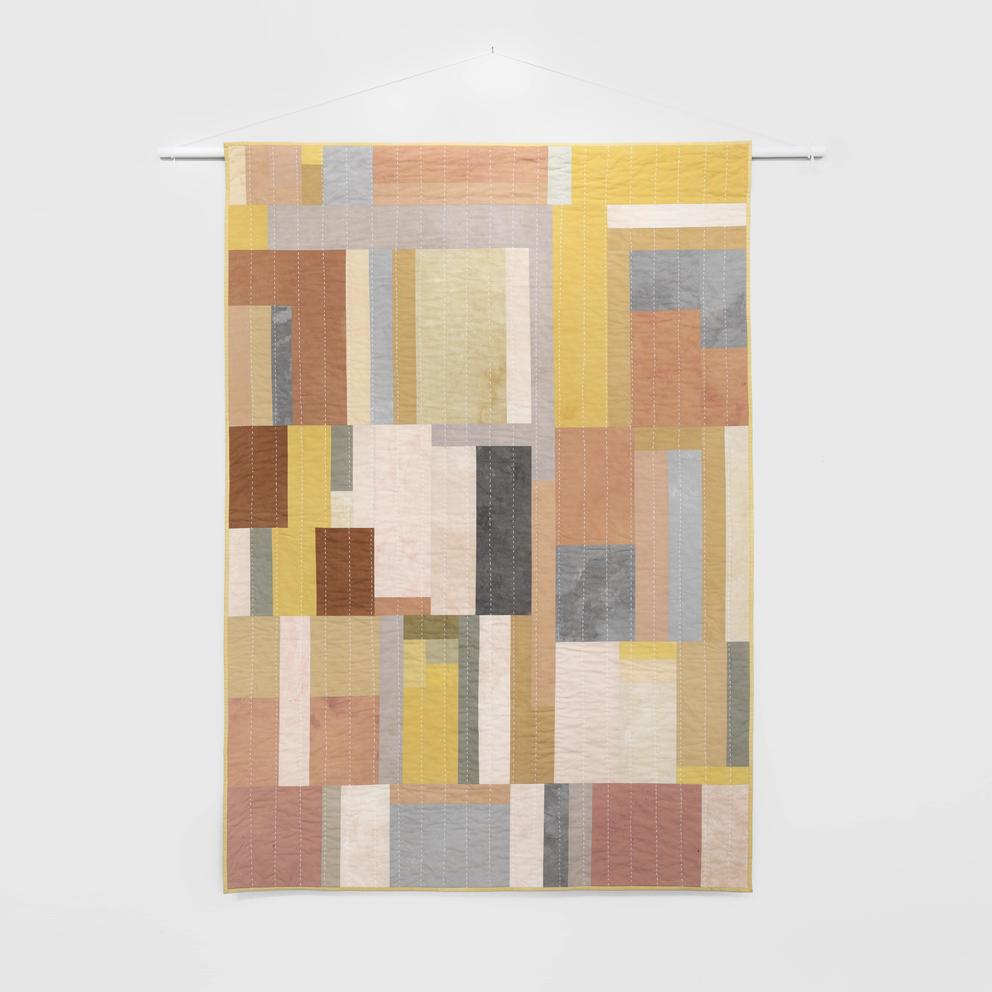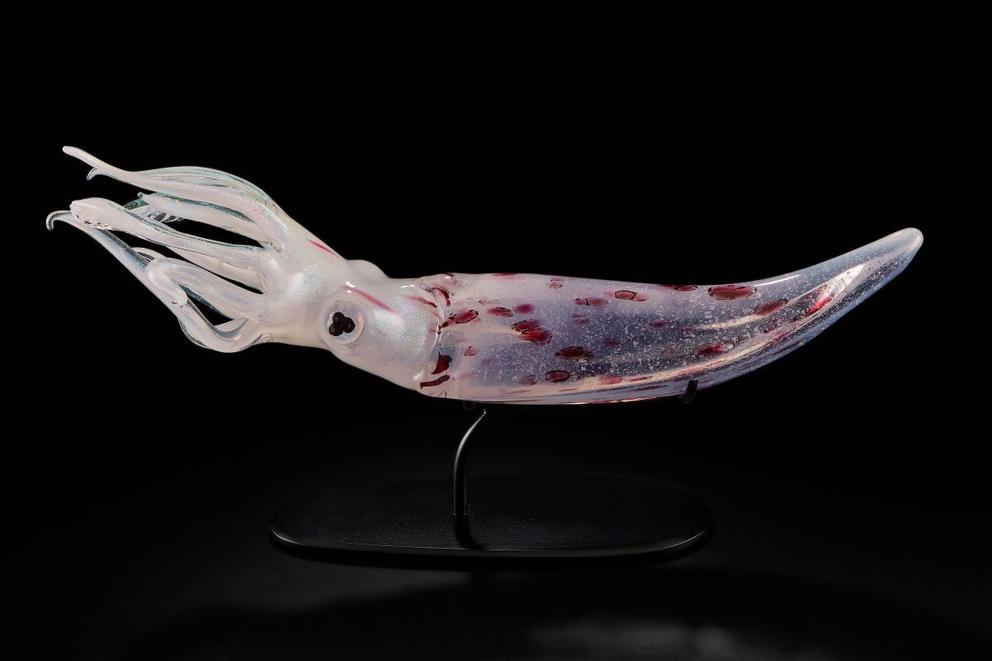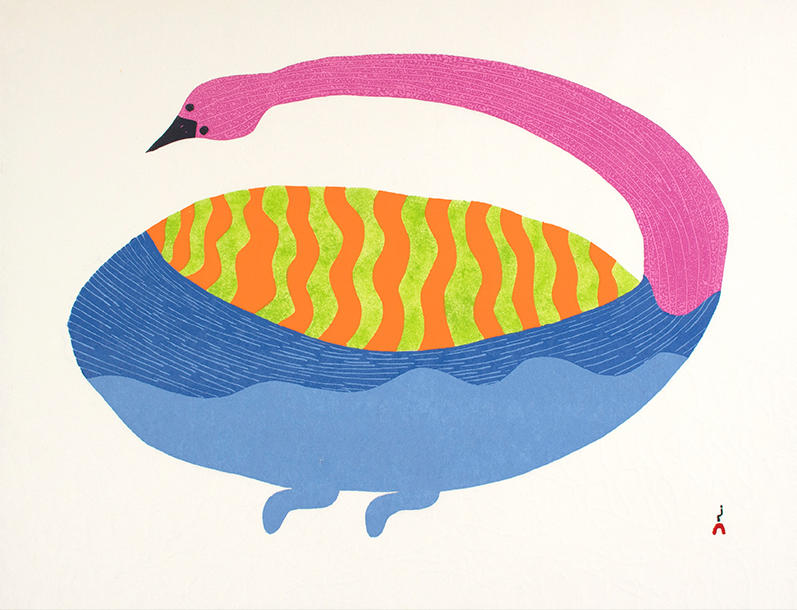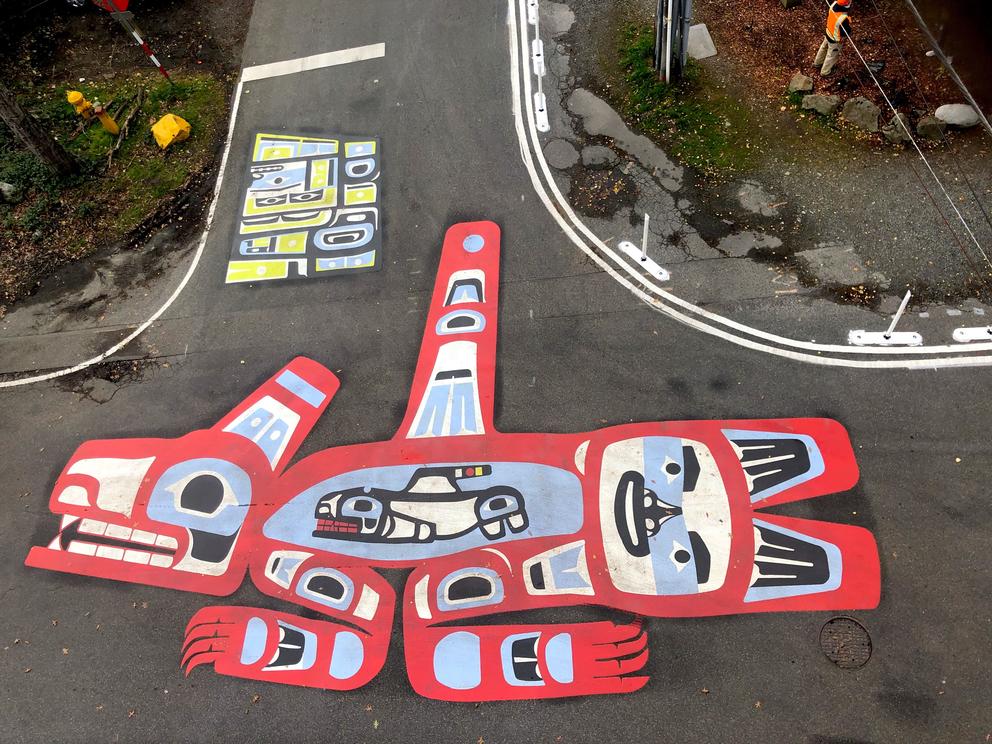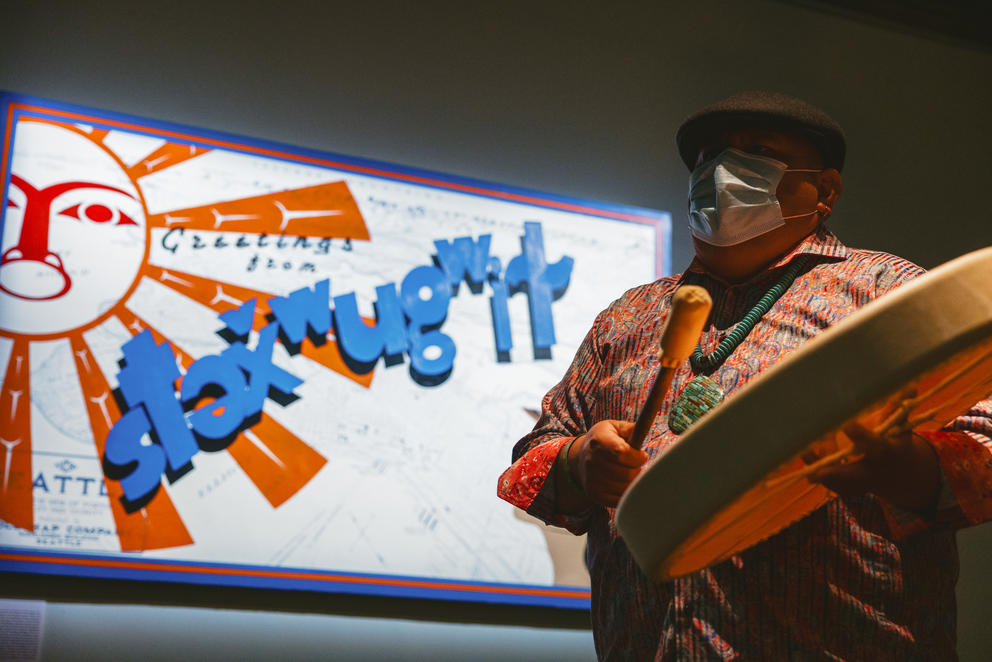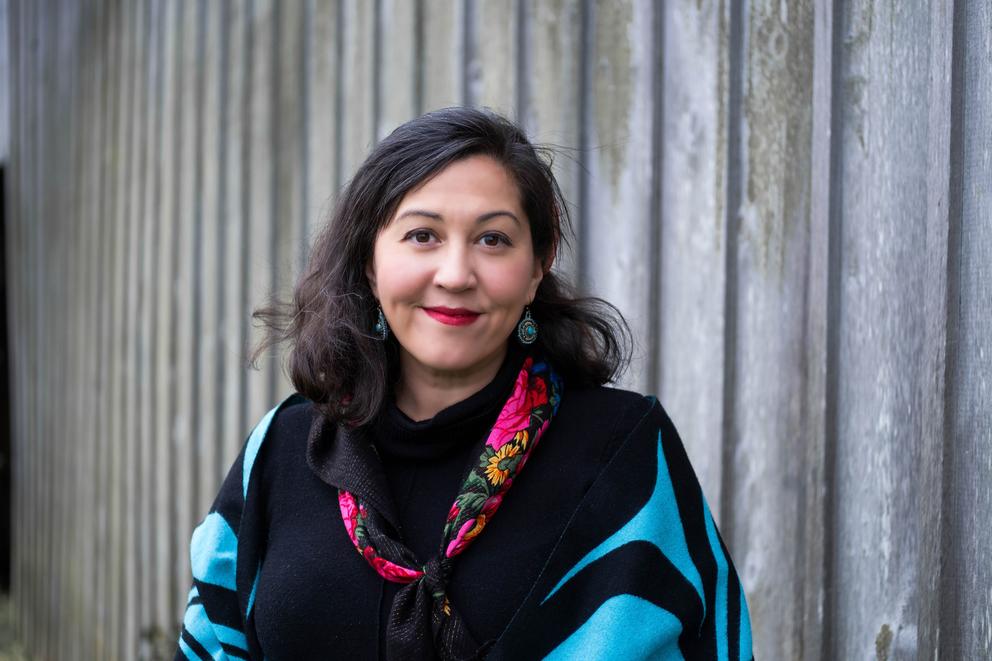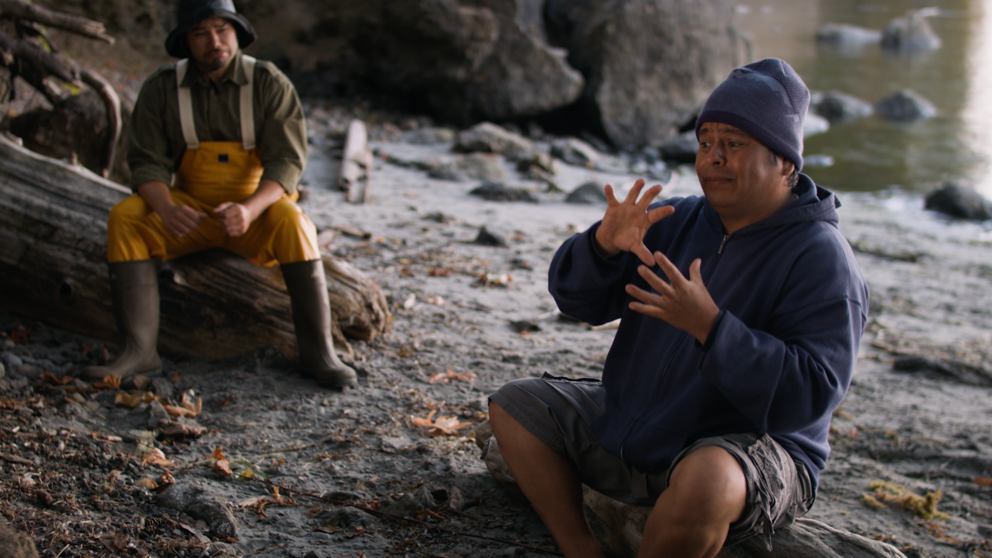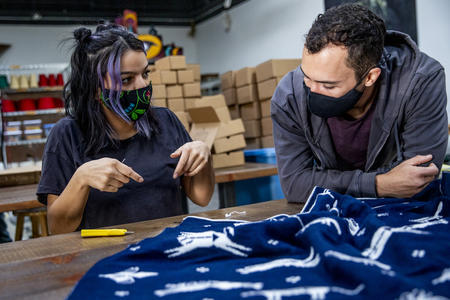Gallery and museum shows
In an expansive new show at the Frye Art Museum, Canadian First Nations artist Duane Linklater (Omaskêko Cree) explores the complexities of his own identity. Duane Linklater: mymothersside (through Jan. 16, 2022), is a series of varied installations that includes his visually arresting “flat sculptures.” These naturally dyed linen semicircles — emulating the canvas covering on a tepee, a traditional Cree structure — dot the walls like enormous moths, occasionally fluttering onto the floor. This deconstruction and unusual arrangement suggests displacement, while Linklater’s continual updates to the show speaks to an ever-evolving sense of self.
Exit the Frye “through the gift shop” to see the beautiful new quilt by Naomi Parker. The Tacoma artist and graphic designer, who is Chippewa Cree, Yakama and an enrolled member of the Makah tribe, created the quilt using an elaborate natural dying process that involved Japanese maple leaves, avocado pits and several baths, including tannin and alum.
Another thought-provoking wall hanging is “Charmed — Canoe Journey,” by longtime Northwest artist Joe Feddersen, a member of the Colville Confederated Tribes (Okanagan and Arrow Lakes). The work, on view at the Museum of Glass in Tacoma as part of the new group show What Are You Looking At?: An Eccentric Chorus of Artists Working in Glass (through fall 2022), is a large-scale tapestry of sorts, constructed of clear glass strands fused into petroglyphs. Suspended from the ceiling, the piece casts a shadow that reveals a tale of people, animals, boats, bricks, utility poles and jetliners.
Stories old and ongoing are also the subject of a new show at the Washington State History Museum. As Grandmother Taught: Women, Tradition and Plateau Art (through Nov. 28) showcases the matrilineal Indigenous art of the Columbia River Plateau by way of three contemporary Native artists: HollyAnna CougarTracks DeCoteau Littlebull, Bernadine Phillips and Leanne Campbell. The array of craftwork includes baskets, weavings, wood carvings and elaborate beadwork pieces, from human garments to horse regalia.
Still on extended view (and still worth seeing) at the Tacoma Art Museum is Native Portraiture: Power and Perception, which juxtaposes romanticized Western portraits of Native Americans by non-Native artists with Indigenous portraits made by contemporary Native artists. And while you’re in the neighborhood, don’t miss “Mini Tahoma,” the massive new outdoor installation by RYAN! Feddersen (Joe’s niece), which gives a decommissioned brutalist fountain new life as an artwork by way of paint, sculptural pieces, lighting and about 33,000 pounds of post-consumer glass.
Glass is also at the center of Luminosity: Northwest Native Glass Art (through Nov. 27) at Stonington Gallery. The show features new work by three local superstars of the form: Preston Singletary (Tlingit), Dan Friday (Lummi) and Raven Skyriver (Tlingit). Traditional Northwest coast formline designs translate beautifully into contemporary glass, as seen in Singletary’s glowing totems, animal figures and Tlingit baskets. Friday creates glass baskets, too, but with an entirely different pattern. Instead of precise geometry, his lines bend like the woven grasses they are meant to emulate. Skyriver’s glass menagerie includes fantastically fluid whales and salmon (some of which he created with Singletary), several squids, a realistic seal head and a spectacular chambered nautilus (a collaboration with fellow Northwest glass artist Kelly O’Dell).
Fans of Dan Friday get another chance to see his work in an incredible solo show at the Museum of Northwest Art in La Conner: Future Artifacts (now extended through Jan. 2, 2022). In his artist statement, Friday laments that much of the physical evidence of his ancestral Lummi heritage has disintegrated, because cedar baskets, wool blankets, reef nets and totem poles were made of natural materials. With a variety of glass forms (including glass replicas of the stone anchors used in reef netting and a huge school of glass fish) he aims to tell the story of his people in what he hopes is a more lasting medium.
At Seattle’s Steinbrueck Native Gallery, visitors will find a series of brightly hued formline paintings on canvas and birch panel by Oweekeno artist Steve Smith or Dla'kwagila (through Dec. 31). Also on view: a series of intriguing prints made by Inuit artists at Kinggait Studios in Cape Dorset, Nunuavut (through Dec. 1) and Expressions in Adornment, a showcase of hand-carved and hand-finished Native jewelry (Nov. 23 – Dec. 23).
New outdoor art
From giant steel-and-glass squids to ocean monsters on the pavement, the Puget Sound region is experiencing an exciting influx of outdoor art by Indigenous creators, which presents the perfect COVID-safe art outing, provided you don your rain gear.
The region’s newest piece of literal street art is a mural by Seattle artist Romel Belleza (Ilocano, Tlingit and Dishchii Bikoh N’Dee) on the asphalt of a “Stay Healthy” street in the Little Brook neighborhood of Lake City. In bright red and baby blue, the Tlingit ocean monster — a traditional creature in Shatx’Heen Kwaan storytelling — guards the intersection alongside two smaller, Chilkat blanket sections.
Further North, at 12049 Beverly Park Road in Everett, artist Nahaan also opted for tart red and cyan blue (plus purple and white) on his billboard featuring two eagles and a central visionary or medicine man demanding “LAND BACK.” The artwork is one of 20 billboards installed across North America as part of a campaign in support of the landback movement, which aims to get Indigenous lands back into Indigenous hands.
In Ferndale, near Bellingham, Lhaq’temish (Lummi) Nation artists Jason LaClair and Yolanda Felix-Wilbur recently completed two murals on the west side of the Pioneer Park Pavilion. LaClair opted for two Coast Salish-style eagles facing each other in the shape of a heart, while Felix-Wilbur depicted the traditions of the potlatch and canoe journey.
While most of Seattle’s large-scale public art projects are slated to premiere next year or later, you can already spot some great works around the city. At the Climate Pledge Arena, you can catch “La Diab Pish,” by prominent Northwest glass artist Preston Singletary and sculptor David Franklin. Made of laminated red glass and stainless steel, the symmetrical, eight-armed piece depicts a giant Pacific octopus in a “pan-coastal” Native style, a nod to Singletary’s Tlingit heritage.
Inside “the Pledge” (but viewable through the windows at the plaza level), artist Jeffrey Veregge (Port Gamble/S’Klallam) painted a large stretch of wall with a stacked regional timeline in his signature, self-described “Salish geek” graphic style, which combines Coast Salish design elements with mod cartoony figures and retro-futurist robots.
Seattle’s historic University District theater The Neptune is celebrating its 100-year anniversary this month with, among other updates, a new lobby painting by Joseph H. (wahalatsu?) Seymour (Squaxin Island/Pueblo of Acoma), which fuses a vintage “Welcome” postcard motif with a birds-eye map of the area and Lushootseed place names.
And if you want to see a new artwork in progress, head to Pioneer Square, where this week crews will start working on RYAN! Feddersen’s 26-by-74-foot beadwork-inspired tile mural for the new Citizen M hotel.
Historical exhibits
Native American Heritage Month continues this week, and feels especially relevant during the Thanksgiving weekend. With the debunking of the holiday’s origin story comes an opportunity for better understanding of the historical record. These exhibits can help do so — as well as alter your perspective on the present.
>> The Suquamish Museum is located on the Port Madison Indian Reservation, just steps from the grave of Chief Sealth (also definitely worth a visit), the famous Indigenous leader for whom the city of Seattle is named. In 1911, the Suquamish tribal community established the tradition of Chief Seattle Days — a festival that includes a salmon bake, canoe races, baseball, drumming and dancing, as well as a Chief Seattle gravesite ceremony in his honor. The museum’s latest exhibit, Chief Seattle Days (through Jan. 9, 2022), charts the tradition’s long history.
>> The Duwamish Longhouse and Cultural Center and the Southwest Seattle Historical Society have curated a collaborative set of exhibits titled The Spirit Returns 2.0: A Duwamish and Settler Story. It’s meant to be a revisiting of the 2001 exhibit The Spirit Returns: A Duwamish and Pioneer Story at the Historical Society/Log House Museum, which explored the relationships between the Duwamish and non-native settlers who arrived in the 1850s. This joint approach reflects a shift in how institutions are reconsidering history and language (“settler” vs. “pioneer”) and their approach to both. Also new is that the exhibit now stretches out over two locations (through April 17, 2022 at the Log House Museum; indefinitely at the Longhouse) — back in 2001, the Duwamish Longhouse wasn’t built yet.
>> Amid 50 acres of forest and wetlands, the voluminous building of the The Hibulb Cultural Center (on the Tulalip Reservation) is packed with art, artifacts and history. It starts in the grand canoe hall with two tall cedar welcome figures. The current exhibit, The Power of Words: A History of Tulalip Literacy, includes a history of the Lushootseed alphabet (developed in the 1960s), initiatives for language preservation and an exact replica of the Treaty of Point Elliott of 1855, that founding document of the Pacific Northwest, which remains a living text still used in legal cases determining Native sovereignty.
Movies and virtual events
Due to experience gained by all those pandemic pivots, virtual art events abound this year, which means you can enjoy including Native films, visual art shows and readings from your couch.
>> Washington state’s poet laureate, Bellingham-based poet Rena Priest (a member of the Lhaq'temish/Lummi Nation), will join two other Indigenous poets, New Zealand-based Iona Winter (Waitaha/Kāti Māmoe/Kāi Tahu/Pākehā) and Tacoma-based Sasha LaPointe, a Coast Salish author from the Nooksack and Upper Skagit Indian tribes for a reading co-hosted by Seattle City of Literature and Dunedin (NZ) City of Literature. The writers will discuss their work and shared resonances in a prerecorded virtual talk (Dec. 1, 6-7 p.m. Free).
>> “Three years, two months and nine days,” says Ken Workman, the great-great-great-great-grandson of Chief Seattle, “from the time that the Denny Party landed at Alki Point on November 13, 1851, to the signing of the Point Elliott treaty in 1855.” This astonishingly brief time span becomes an incantation in Three Years, a new short (streaming free, online) by Seattle filmmaker B.J. Bullert. In simple scenes shot on a windy day at Alki Beach, Workman repeats the timeline, and explains in Lushootseed how Chief Seattle initially welcomed the new arrivals: “Come ashore my friends, come ashore onto this ancient land of the Duwamish.” When the wind kicks up, Workman’s words seem to push the waves backward, as if to reverse time. “The Duwamish remain,” he says. “We are fixed to the land. We are still here.”
>> The multidisciplinary arts group yəhaw̓ Indigenous Creatives Collective recently premiered two online visual art exhibits. Telling Our Own Stories: Afro-Indigenous Creatives, curated by local artist Brit Reed, includes short films, multimedia collages, beadwork, music, quilts and digital artwork by artists from across the Western Hemisphere. A second virtual, multimedia art show featuring intriguing artworks (also curated by Reed) chronicles Indigenous responses to COVID-19 under the banner of Being A Good Ancestor. As Reed writes, these are the questions posed to artists: “How are you being a good ancestor as we go through this era of COVID-19, a continuing Civil Rights Movement, and political strife? What stories from the past, from the ancestors, are inspiring your actions today?”
>> Three Dollar Bill Cinema is streaming a virtual Indigenous showcase consisting of two feature-length and two short films (Nov. 19-29). Being Thunder follows a two-spirit gender-queer teenager from the Narragansett tribe in Rhode Island, and in Fire Song, a gay Anishinaabe teenager grapples with a life-changing event. Also in the lineup is the short Drive to Top Surgery, by local Emmy-award-winning creator and director Raven Two Feathers, who will moderate a panel of Indigenous filmmakers on Nov. 21 at 1 p.m. on Three Dollar Bill’s Facebook and YouTube pages.
>> Another local movie to add to your list is the short doc Honor Thy Mother, a fascinating film that reveals a little known chapter of local history. Through on-screen interviews and archival photos, descendants tell the stories of mothers in the “Indipino” community of Bainbridge Island, which formed in the 1940s when Indigenous women from Canada, Alaska and Washington moved to the island to pick strawberries alongside Filipino workers on Japanese-owned farms. The film screens in-person at the Edmonds Diversity Film Series (Nov. 20 at noon) and at the Bainbridge Island Museum of Art (Nov. 23 at 2 p.m. and 7 p.m.) as part of smARTfilms: Indigenous Filmmakers/Indigenous Lives film festival. Those wanting a home screening can rent the film through the Seattle Public Library or order a DVD.
>> Called “a triumph” by IndieWire, the coming-of-age drama Beans — the first fictional film directed by documentarian Tracey Deer — centers on a young Mohawk girl Tekahentahkhwa, aka Beans, through whose eyes we see the Kanesatake Resistance of 1990, a 78-day standoff between a group of Mohawk people protesting the development of disputed land and Canadian law enforcement. The film screens in-person at Northwest Film Forum (Nov. 20-21) and virtually at SIFF (through Dec. 9).
>>The Haudenosaunee Confederacy’s Great Law of Peace united six Indigenous nations in an alliance that predates the American Constitution by centuries and served as an example of participatory democracy, federalism and separation of powers. In an online Humanities Washington’s Speakers Bureau talk, “American Democracy’s Indigenous Roots and Future,” (Dec. 4, 2 p.m. Free) Fern Naomi Renville — a Sisseton Wahpeton Dakota, Omaha and Seneca-Cayuga storyteller, theater director and playwright — will highlight the matriarchal power of this law and union.
>> Last November, as in-person art was still very much a question mark, artists and storytellers Fern Naomi Renville (Sisseton Wahpeton Dakota, Omaha and Seneca-Cayuga) and Roger Fernandes (Lower Elwha S’Klallam) released their reimagined play — originally slated to premiere on the stage of Sound Theatre Company — Changer and the Star People as an audio play. A year later, the retelling of a Coast Salish origin story has taken on a new shape, this time as a movie. Changer: A Hand Telling (streaming online, suggested donation), filmed on the traditional lands of the Lower Elwha S’Klallam Tribe, stars deaf Native actors G. Christian Vasquez and Roberto Sandoval and was directed by deaf director Howie Seago. The movie features spoken English, as well as Native and American Sign Languages and English subtitles.
Art markets and shopping
Reduce the hassle of supply chain issues — and support local artists! — by shopping for holiday gifts and art at these local markets that emphasize Indigenous design.
>> A traditional salmon bake lunch, midday music and dance and drum performances augment the shopping experience at the United Indians Native Art Market at Daybreak Star Cultural Center in Discovery Park (where the nonprofit launched its Indigenous music-focused radio station earlier this year). Expect to find and clothing, jewelry, woodworking, drums, art prints and more Nov. 20-21 (10 a.m.–6 p.m.) and Dec. 18-19 (10 a.m.–6 p.m).
>> The pandemic hasn’t stopped the United Indians of All Tribes Foundation from expanding its footprint in other ways, too. This past summer, the nonprofit opened a third outpost of its Sacred Circle Gallery and Gift Shop in Ballard (other locations are in the Seattle-Tacoma International Airport and Daybreak Star). In Ballard, Tlingit artist Alison Bremner shows her pop-culture-populated formline paintings (through Dec. 31), and at Daybreak Star, artist, children’s book writer and chef Ramon Shiloh (Creek, Cherokee, Filipino, African American) paints “Invisible Problems Well Documented,” such as environmental degradation and colonialism (through Dec. 31).
>> The Suquamish Museum is holding a Black Friday sale (Nov. 19 – 24) at its Leota Anthony museum store (with discounts for museum members, tribal government employees and Suquamish tribal members), where you’ll find hand-pounded copper jewelry, cedar art pieces, hand-tooled belts and hair adornments by Suquamish artists.
>> The Suquamish museum is also organizing two pop-up shops featuring creations by Tlingít jewelry maker Kayla Wave, of The Fox & The Fawn (Nov. 20, 11 a.m. – 3 p.m.); and Azure Boure, the Suquamish Tribe's traditional foods and plants specialist, who creates healing salves, teas and more. (Nov. 21, 11 a.m.–3 p.m.). Both Wave and Boure will be on-site doing demonstrations and answering questions.
>> This winter marks the return of the Duwamish Tribe’s Native art market and holiday gift fair (Nov. 25-28, 10 a.m.-5 p.m.) at the Duwamish Longhouse, where you can browse paintings, prints, drums, bead work and wood carvings — not to mention soup and fry bread by Cecile Hansen.
>> This year, your best bet for scoring the coveted T-shirts, beaded jewelry and leather bracelets crafted by apprentices and benefiting the Chief Seattle Club is visiting Native Works’ online store.
>> Eighth Generation, the Seattle-based, Native-designed art and lifestyle business, recently announced a major partnership with local-but-global coffee behemoth Starbucks. Five Coast Salish artists, including Andrea Wilbur-Sigo (Squaxin Island), Gail White Eagle (Muckleshoot) and Eighth Generation CEO Louie Gong (Nooksack), designed a capsule collection of throw blankets, a “demi” mug set patterned with textures traditionally found in Salish weavings and basketry, as well as a jacket and ceramic tumbler. Most of the special collection is available for purchase only at Eighth Generation’s Pike Place Market storefront and the Starbucks Reserve Roastery on Capitol Hill. (The demi mugs are also available in Eighth Generation’s online shop, where you can also find the brand’s trademark prints, phone covers, jewelry, T-shirts and wool blankets.) In the process of the partnership, the brand made a few artist-empowering changes to Starbucks’ customary artist collaboration model, proving, says CEO Gong, that “a small Native-owned company with courage and good ideas can impact big business.”
Get the latest in local arts and culture
This weekly newsletter brings arts news and cultural events straight to your inbox.


